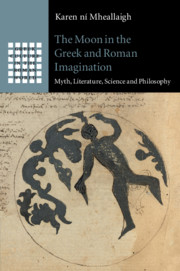Book contents
- The Moon in the Greek and Roman Imagination
- Greek Culture in the Roman World
- The Moon in the Greek and Roman Imagination
- Copyright page
- Dedication
- Contents
- Acknowledgements
- Abbreviations, Text References and Translations
- Part I The Moon in the Mythic Imagination
- Part II The Moon in the Scientific Imagination
- Part III The Moon in the Fantastic Imagination
- Bibliography
- Index
- Index Locorum
- References
Bibliography
Published online by Cambridge University Press: 09 October 2020
- The Moon in the Greek and Roman Imagination
- Greek Culture in the Roman World
- The Moon in the Greek and Roman Imagination
- Copyright page
- Dedication
- Contents
- Acknowledgements
- Abbreviations, Text References and Translations
- Part I The Moon in the Mythic Imagination
- Part II The Moon in the Scientific Imagination
- Part III The Moon in the Fantastic Imagination
- Bibliography
- Index
- Index Locorum
- References
Summary

- Type
- Chapter
- Information
- The Moon in the Greek and Roman ImaginationMyth, Literature, Science and Philosophy, pp. 295 - 316Publisher: Cambridge University PressPrint publication year: 2020

